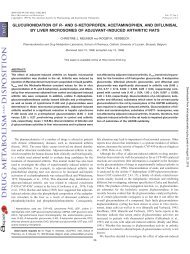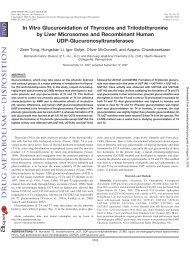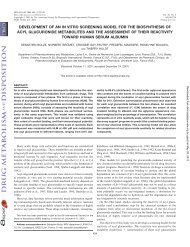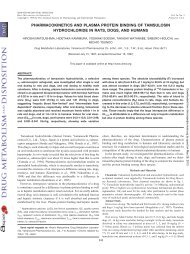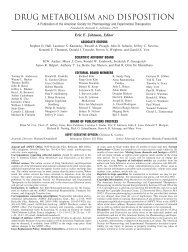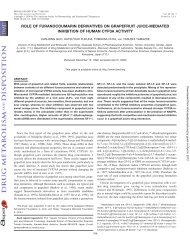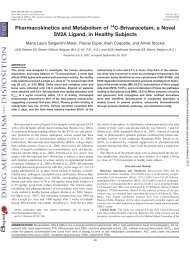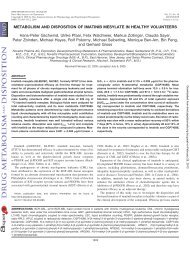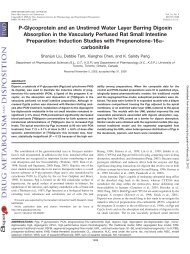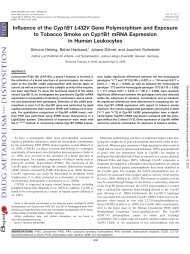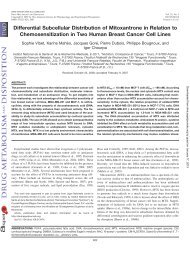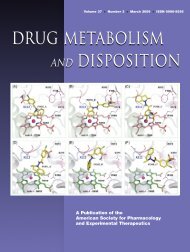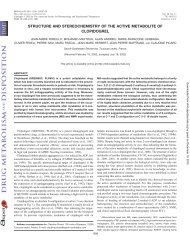trimethylaminuria: the fish malodor syndrome - Drug Metabolism and ...
trimethylaminuria: the fish malodor syndrome - Drug Metabolism and ...
trimethylaminuria: the fish malodor syndrome - Drug Metabolism and ...
You also want an ePaper? Increase the reach of your titles
YUMPU automatically turns print PDFs into web optimized ePapers that Google loves.
520 TRIMETHYLAMINURIA: THE FISH MALODOR SYNDROME<br />
TABLE 4<br />
Proposed classification of various types of <strong>fish</strong> <strong>malodor</strong> <strong>syndrome</strong><br />
1. Primary genetic<br />
2. Acquired/viral infection<br />
3. Transient childhood<br />
4. Transient menstruation<br />
5. Precursor overload<br />
Two apparently relative common polymorphisms, P153L <strong>and</strong><br />
E305X, appear to account for <strong>the</strong> majority of severe cases of <strong>fish</strong><br />
<strong>malodor</strong> seen in patients to date (Dolphin et al., 1997; Treacy et al.,<br />
1998). One of <strong>the</strong>se, P153L, has been found to cosegregate within a<br />
family pedigree with expression of <strong>the</strong> disorder. Besides <strong>the</strong>se, o<strong>the</strong>r<br />
mutations of FMO3 (see Table 5) have been described, some associated<br />
with <strong>the</strong> inactivation of FMO3. In addition, it appears that <strong>the</strong>re<br />
may be combinations of intragenic polymorphisms within FMO3 that<br />
determine a modified <strong>and</strong> less severe form of <strong>the</strong> condition (Akerman<br />
et al., 1999a; Zschocke et al., 1999). These advances should now<br />
make it possible to diagnose <strong>the</strong> disorder at <strong>the</strong> molecular level as well<br />
as identifying carriers.<br />
2. Acquired Form. There are at least three cases known of individuals<br />
with clinical <strong>and</strong> biochemically diagnosed <strong>fish</strong> <strong>malodor</strong> <strong>syndrome</strong><br />
(Ruocco et al., 1989; S. C. Mitchell <strong>and</strong> R. L. Smith, unpublished<br />
data) where <strong>the</strong> condition appeared to emerge in adult life.<br />
There was no previous history in childhood <strong>and</strong> <strong>the</strong>re was no familial<br />
background to <strong>the</strong> disorder. What appeared common to <strong>the</strong> three cases<br />
was evidence of hepatitis, possibly viral, in adult life <strong>and</strong> this may<br />
have been responsible for precipitation of <strong>the</strong> condition possibly by<br />
insertion of viral DNA into <strong>the</strong> genome <strong>the</strong>reby affecting normal<br />
expression of <strong>the</strong> human FMO3 gene.<br />
3. Transient Childhood Forms. A preterm infant (29-weeks old)<br />
who developed a <strong>fish</strong> odor while being fed a choline-containing food<br />
supplement has been described (Blumenthal et al., 1980). When <strong>the</strong><br />
choline supplement was withdrawn <strong>the</strong> odor disappeared, <strong>and</strong> it failed<br />
to reappear at 8 months of age when <strong>the</strong> supplement was reinstituted.<br />
When <strong>the</strong> supplement was given to three o<strong>the</strong>r preterm infants of<br />
similar weights <strong>and</strong> ages, one of <strong>the</strong>se developed a <strong>fish</strong> odor. The<br />
authors attributed <strong>the</strong> <strong>fish</strong> odor associated with <strong>the</strong> choline-containing<br />
supplement to <strong>the</strong> immaturity of <strong>the</strong> N-oxidase enzyme. Since <strong>the</strong>n,<br />
o<strong>the</strong>r cases of pediatric <strong>fish</strong> <strong>malodor</strong> <strong>syndrome</strong> have been described<br />
(Mayatapek <strong>and</strong> Kohlmuller, 1998). During early childhood a transient<br />
or mild form of <strong>trimethylaminuria</strong> may occur. Molecular analyses<br />
in some cases can reveal compound heterozygosity for several<br />
mutations. Recent studies suggest that both severe <strong>and</strong> variant mild<br />
<strong>trimethylaminuria</strong> is much more common than hi<strong>the</strong>rto recognized<br />
(Zschocke et al., 1999).<br />
4. Transient Form Associated with Menstruation. Several of our<br />
female patients told us anecdotally of how <strong>the</strong>ir <strong>fish</strong>y odor seemed to<br />
intensify with <strong>the</strong> onset of menstruation (Ayesh et al., 1993). A<br />
subsequent study of a single female <strong>fish</strong> <strong>malodor</strong> patient showed that<br />
her trimethylaminuric condition deepened just before <strong>the</strong> onset of<br />
menstruation <strong>and</strong> that this biochemical feature related closely to her<br />
own subjective description (Zhang et al., 1996b). A systematic study<br />
has confirmed that in normal healthy women of menstruating age<br />
<strong>the</strong>re occurs a short episode of <strong>trimethylaminuria</strong> just at <strong>the</strong> onset of<br />
<strong>and</strong> during menstruation that <strong>the</strong>n disappears. By contrast in male<br />
subjects, <strong>the</strong>re was no evidence of this cyclical variation (S. C.<br />
Mitchell <strong>and</strong> R. L. Smith, unpublished data). Although this may be an<br />
interesting phenomenon in its own right, particularly with respect to<br />
possible hormone modulation of flavin monooxygenase activity, it is<br />
also of diagnostic importance because a sample taken at this time <strong>and</strong><br />
analyzed for trimethylamine <strong>and</strong> trimethylamine N-oxide might lead<br />
TABLE 5<br />
Point mutations of human FMO3 associated with <strong>fish</strong> <strong>malodor</strong> <strong>syndrome</strong><br />
a Inactivates FMO3.<br />
Position Mutation<br />
61 Asn 3 Ser a<br />
82 Met 3 Thr a<br />
153 Pro 3 Lev a<br />
158 Glu 3 Lys<br />
180 Gly 3 Val<br />
257 Val 3 Met<br />
305 Glu 3 X a<br />
434 Met 3 Iso a<br />
492 Arg 3 Trp a<br />
661 Met 3 Iso a<br />
to an incorrect diagnosis of inherited (primary genetic) <strong>fish</strong> <strong>malodor</strong><br />
<strong>syndrome</strong> whereas <strong>the</strong> condition may only be transitory.<br />
5. Precursor Overload. A few cases of a transient form of <strong>the</strong> <strong>fish</strong><br />
<strong>malodor</strong> <strong>syndrome</strong> have been attributed to precursor overload <strong>the</strong>reby<br />
saturating <strong>the</strong> existing levels of flavin monooxygenase. Trimethylamine<br />
is mostly derived from dietary precursors such as choline,<br />
carnitine, <strong>and</strong> trimethylamine N-oxide through enterobacterial metabolism.<br />
Exposure to unusually high levels of such precursors may<br />
hasten a <strong>fish</strong> <strong>malodor</strong> <strong>syndrome</strong> especially if <strong>the</strong> individual is a<br />
haplotype for certain mutations. Large oral <strong>the</strong>rapeutic doses of choline<br />
(8–20 g/day) have been used to treat Huntington’s chorea, <strong>and</strong><br />
although <strong>the</strong>re was some improvement in <strong>the</strong> clinical picture, patients<br />
complained of a striking <strong>fish</strong>-like odor, which was attributable to <strong>the</strong><br />
generation of excessive amounts of trimethylamine that exceeded<br />
<strong>the</strong>ir enzyme’s capacity to oxidize it to <strong>the</strong> non-offensive N-oxide<br />
(Growdan et al., 1977). It is noteworthy that <strong>the</strong> precursors of trimethylamine,<br />
choline <strong>and</strong> lecithin, sometimes recommended in quite<br />
high doses in health foods, food supplements, <strong>and</strong> alternative diets<br />
could lead to <strong>the</strong> problems outlined above.<br />
Clinical Aspects of <strong>the</strong> Fish Malodor Syndrome<br />
The principle consequences of <strong>the</strong> <strong>fish</strong> <strong>malodor</strong> <strong>syndrome</strong> appear in<br />
<strong>the</strong> main to be psychosocial in nature although <strong>the</strong>re are some o<strong>the</strong>r<br />
observations that deserve to be followed up. The psychosocial reactions<br />
appear to arise from <strong>the</strong> excretion of excessive amounts of<br />
<strong>malodor</strong>ous trimethylamine in <strong>the</strong> sweat, breath, urine, <strong>and</strong> o<strong>the</strong>r<br />
bodily secretions <strong>the</strong>reby conferring a powerful <strong>and</strong> offensive body<br />
odor. The latter, as well may be imagined, can be highly destructive<br />
to personal, working, <strong>and</strong> career lives of <strong>the</strong> affected individuals.<br />
Some individuals become socially withdrawn <strong>and</strong> isolated <strong>and</strong> may go<br />
on to develop mental depression (Todd, 1979; Shelley <strong>and</strong> Shelley,<br />
1984; Ayesh et al., 1993). The condition can be particularly acute <strong>and</strong><br />
severe for young children <strong>and</strong> adolescents who may be subject to<br />
ridicule, lose confidence, <strong>and</strong> even schooling.<br />
It is a moot point as to whe<strong>the</strong>r <strong>the</strong> mental depression that is seen<br />
in some cases, but by no means all, is attributable to <strong>the</strong> debilitating<br />
social isolation that some experience or whe<strong>the</strong>r it arises from <strong>the</strong><br />
dysfunctional metabolism of o<strong>the</strong>r endogenous substrates. Endogenous<br />
amines such as tyramine are substrates for FMO3, which is<br />
expressed in <strong>the</strong> brain (Bhamre <strong>and</strong> Ravindranath, 1991; Bhamre et<br />
al., 1995; Lin <strong>and</strong> Cashman, 1997). What does seem to come through<br />
in <strong>the</strong> various studies is that <strong>the</strong> severity of <strong>the</strong> <strong>syndrome</strong> is highly<br />
variable; in some individuals, it is severe, in o<strong>the</strong>rs less so <strong>and</strong><br />
sometimes it seems to be more episodic in nature. Ano<strong>the</strong>r curious<br />
feature is that although some sufferers are cognizant of <strong>the</strong> smell of<br />
<strong>the</strong>ir condition o<strong>the</strong>rs remain unaware (Ayesh et al., 1993).<br />
Downloaded from<br />
dmd.aspetjournals.org by guest on December 6, 2012



